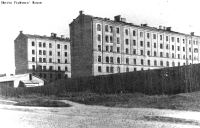The HKP 562 (
Heeres-Kraftfahr-Park / Vehicle Repair Park) was a
Wehrmacht military unit that was
responsible for the repair and re-establishment of
Wehrmacht vehicles.
 |
| Main Workshops |
The main HKP 562 works, with its large vehicle repair workshops and its spare parts department, as well as the
HKP Headquarters, were located at the eastern outskirts
of Vilnius. The HKP 562 also supervised 16 other vehicle workshops, mainly
privately directed, which were situated in Vilnius and its surroundings.
The HKP headquarters were located on
Olandu Street, opposite the
entrance to the main HKP workshops. The
HKP "Panzerkaserne" workshops
were on
Valkovsky Street. A third large workshop was at a former bus depot on
Legionowa Street.
 |
| Subocz Street Camp * |
The Jewish forced labourers of HKP were housed in two pre-war blocks (of the Jewish-French
Philantropist Society, built in 1904) on
Subocz Street,
about 1.3 km from the HKP main workshops and the HQ. In
September 1943, just before the
Vilnius Ghetto was to be liquidated, Major
Plagge managed to evacuate
over 1,000 of his
HKP workers and their families from the ghetto to hastily installed workshops
at these two blocks. There the "Plagge-Jews" remained in relative protection for the final months before the Red Army
liberated Vilnius.
On
1 July 1944, as the Red Army approached Vilnius,
Plagge came into the camp and warned the Jews that he and his men would
no longer be in charge of the camp and gave the Jews a covert warning that SS killing squads were coming to the
camp the next day.
The HKP 562 unit left for
Kovno in the early night of
2 July 1944 since they had to leave
Vilnius
by
3 July in accordance with their orders.
Plagge's warning spurred many of the prisoners to immediately go
into hiding before the SS arrived.
Ultimately 250 of the "Plagge-Jews" survived until liberation.
Annotation:
The HKP 562 was different from ordinary
Wehrmacht units or even SS, SD, and other police units, mainly because
it was a specialized “working unit”, solely concerned with the repair and re-establishment of
Wehrmacht
vehicles. This special field also influenced the structure of the hierarchy in such a way, that in ordinary everyday
life the so-called "organizational hierarchy by function" superseded the "military hierarchy by rank".
This meant, related to work tasks, that it was possible for someone of a lower military rank to have greater authority
than a person of a higher military rank.
See "A Letter from Karl Plagge" !
See "Karl Plagge - A Rescuer of Jews in the Uniform of the German Wehrmacht Lecture of
Prof. Dr. Wolfram Wette" !
Photo: GFH
*
Thanks to Irmgard Voshaar and
Dr. Michael Good
www.searchformajorplagge.com
for documents and support.
© ARC 2005








